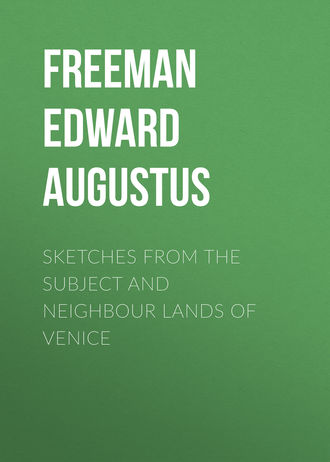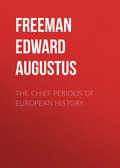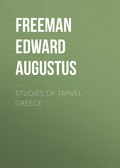
Freeman Edward Augustus
Sketches from the Subject and Neighbour Lands of Venice
Such is now the one city in which the Turk ever ruled on our side of Hadria. In earlier times we might have passed straight from Otranto to the lands where he still rules, or to the island where he never ruled. But now he who looks out for Otranto on the heights of Albania, and whose objects call him to the nearer neighbourhood of those heights, must go back to Brindisi to find his way to reach them.
FIRST GLIMPSES OF HELLAS
1875 – 1881
In our present journey we draw near to the eastern peninsula, to the Hellenic parts of that peninsula, by way of the great island – great as compared with the mass of Greek islands, though small as compared with Sicily or Britain – which keeps guard, as a strictly Hellenic outpost, over a mainland which was and is less purely Hellenic. From Brindisi we sail to Corfu, the elder Korkyra, as distinguished from the black isle of the same name off the Dalmatian shore. In so sailing, we specially feel ourselves to be sailing in the wake of the conquerors who made Corfu an appendage to the Sicilian realm; we are passing between spots on either side which have known both a Norman and Venetian master. But it may be that we may have already drawn near to Greece by another path. It is easy to prolong the voyage which took us from Trieste to Spalato, from Spalato to Cattaro, by a third stage which will take us from Cattaro to Corfu. In this case we may have already studied the Albanian coast, and that with no small pleasure and profit. We may have marked a point not long after we had left Dalmatia behind us, and that where a line may well be drawn. There is a geographical change in the direction of the coast, from the shore of Dalmatia, with its islands and inland seas, its coast-line stretching away to the south-east, to the nearly direct southern line of the shore of Albania. In modern political geography we pass from the dominion of Austria to the dominion of the Turk. In the map of an earlier day, we pass from the all but wholly continuous dominion of the two commonwealths of Venice and Ragusa. In modern ethnology we pass from the Slave under a certain amount of Italian influence to the Albanian under a certain, though smaller, amount of influence, Italian or Greek, according to his local position and his religious creed. In modern religious geography we pass from a land which is wholly Christian, but where the Eastern form of Christianity, though still in the minority, makes itself more deeply felt at every step, to a land where Islam and the two great ancient forms of Christianity are all found side by side. In the geography of earlier times this point marks the frontier of a land intermediate between the barbaric land to the north, with only a few Greek colonies scattered here and there, and the purely Greek lands, the "continuous Hellas," to the south. We find on this western shore of the south-eastern peninsula the same feature which is characteristic of so large a part of the Ægæan and Euxine coasts, both of the south-eastern peninsula itself and of the neighbouring land of Asia. The great mainland is barbarian; the islands and a fringe of sea-coast are Greek. As we draw nearer to the boundary of Greece proper, the Hellenic element is strengthened. Thesprotians, Molossians, Chaonians, were at least capable of becoming Greeks. Epeiros, Ἤπειρος, terra firma, once the vague name of an undefined barbarian region, became the name of a Greek federal commonwealth with definite boundaries. And the character of a barbarian land, fringed with European settlements and looking out on European islands, did not wholly pass away till almost our own day. A few still living men may remember the storming of Prevesa; many can remember the cession – some might call it the betrayal – of Parga. It was only when Parga was yielded to the Turk that this ancient feature of the Illyrian and Epeirot lands passed away. What Corinth had once been Venice was. Corinth first studded that coast with outposts of the civilized world. Venice held those outposts, sadly lessened in number, down to her fall. And the men of Parga deemed, though they were mistaken in the thought, that to the mission of Corinth and Venice England had succeeded.
From whichever side our traveller draws near to Corfu, he comes from lands where Greek influence and Greek colonization spread in ancient times, but from which the Greek elements have been gradually driven out, partly by the barbarism of the East, partly by the rival civilization of the West. Whether we come from Otranto and Brindisi or from the Illyrian Pharos and the Illyrian Korkyra, we are coming from lands which once were Greek. But Otranto and Brindisi, Pharos and Black Korkyra, even Epidamnos and Apollonia, were scattered outposts of Greek life among barbarian neighbours; as the traveller draws near to the elder Korkyra, he finds himself for the first time within the bounds of "continuous Hellas." He may have seen in other lands greater and more speaking monuments of old Hellenic life than any that the island has to show him; he may have seen the lonely hill of Kymê, the hardly less lonely temples of Poseidônia; but those were Greece in Italy; now for the first time he sees Greece itself. Whatever we may say of the mainland to the left, there can be no doubt, either now or in ancient times, of the Hellenic character of the island to the right. There are the small attendant isles; there are the great peaks of Korkyra – not the lowlier peaks which gave city and island their later name – but the far mightier mountains which catch the eye as we approach the great island from the north. That island at least is Hellas – less purely Hellenic, it may be, than some other lands and islands, but still Hellenic, part of the immediate Hellenic world of both ancient and modern days. It was and is the most distant part of the immediate Hellenic world; but it forms an integral part of it. The land which we see is Hellenic in a sense in which not even Sicily, not even the Great Hellas of Southern Italy, much less then the Dalmatian archipelago, ever became Hellenic. From the first historic glimpse which we get of Korkyra, it is not merely a land fringed by Hellenic colonies; it is a Hellenic island, the dominion of a single Hellenic city, a territory the whole of whose inhabitants were, at the beginning of recorded history, either actually Hellenic or so thoroughly hellenized that no one thought of calling their Hellenic position in question. Modern policy has restored it to its old position by making it an integral portion of the modern Greek kingdom. And, if in some things it is less purely Greek than the rest of that kingdom, what is the cause? It is because, if Corfu may be thought for a while to have ceased to be part of Greece, it never ceased to be part of Christendom. It was for ages under alien dominion, but it never was under the dominion of the Turk. The Venetian could to some extent modify and assimilate his Greek subjects; the Turk could modify or assimilate none but actual renegades. And, after all, the main influence has been the other way. If Italian became the fashionable speech, even for men of Greek descent, men on the other hand whose names distinctly show their Italian descent have cast in their lot with their own country rather than with the country of their forefathers. Shallow critics have mocked because men with Venetian names have been strong political assertors of Greek nationality. They might as well mock whenever a man of Norman descent shows himself a patriotic Englishman. They might as well hint that Presidents and Ministers of France and Spain, who have borne names which proclaim their Irish origin, were bound or likely to follow an Irish policy rather than a French or a Spanish one.
The first aspect, indeed every aspect, of the island of Corfu and the neighbouring coast of Epeiros is deeply instructive. The island and the mainland come so close together that, till the eye has got well used to the outline of particular mountains, it is not easy to tell how much is island and how much mainland. A statesman of the last generation twice told the House of Lords that Corfu lay within a mile of the coast of Thessaly. We cannot say, without looking carefully to the scale on the map, how many miles Corfu lies from the coast of Thessaly, any more than we can say offhand how many miles Anglesey lies from the coast of Norfolk. It is a more practical fact that some parts of Corfu lie very near indeed to the coast of Epeiros, though not quite so near as Anglesey lies to the coast of Caernarvonshire. The channel must surely be everywhere more than a mile in width; certainly it could nowhere be bridged, as in the case of Anglesey, or in the cases of Euboia and nearer Leukas. Both coasts are irregular, both coasts are mountainous, and the mountains on both sides fuse into one general mass. Above all, prominent from many points, soars the famous range where, with a singular disregard of later geography,
"Arethusa arose
From her couch of snows
In the Acroceraunian mountains."
Snow of course is in these lands to be had only at a much higher level than the snow-line of the Alps, so that the couch of Arethousa stands out yet more conspicuously over the neighbouring heights than it might have done in a more northern region. The inhabitants of Corfu are fond of pointing to the contrast between the well-wooded hills and valleys of their own fertile island and the bare, almost uninhabited, land which lies opposite to them. And of course they do not fail to point the inevitable moral. As in most such cases, there is truth in the boast, but truth that needs some qualifications. Corfu, through all its changes of masters, has always been under governments which were civilized according to the standard of their own times. It has fared accordingly. Epeiros has been handed over to a barbarian master, and it has also been largely colonized by the least advanced of European races. Besides having the Turk as a ruler, it has had the Albanian, Christian and Mussulman, as a settler. In Corfu the Albanian is a frequent visitor; his sheepskin and fustanella may be constantly seen in the streets of Corfu; but he has not – unless possibly in the shape of refugees from Parga – formed any distinct element in her population. It is only in the nature of things that Greeks under successive Venetian, French, and English rule should do more for their land than Albanians under Turkish rule. But we may doubt whether any people under any government could have made the land opposite to Corfu like Corfu itself. Had the mainland shared the successive destinies of the island, it would doubtless have been far better off than it has been. But it could hardly have been as the island. One point of advantage for the island was the mere fact that it was an island. In all but the highest states of civilization, this is an advantage beyond words; and the ancient colonists fully understood the fact.
Still it is a striking contrast to pass across the narrow sea from Corfu to what was Butrinto. Buthrotum, the mythical city of the Trojan Helenos, has a more real being as a Roman colony, and as one of those outposts on the mainland in which Venice succeeded the Neapolitan Kings, and which she kept down to her own fall. Butrinto was once a city no less than Corfu; to Virgil's eyes it was the reproduction of Troy itself. Now we cross from the busy streets and harbour of Corfu to utter desolation at Butrinto. The desolation is greater in one way than any that Helenos or any other primitive settler could have found, because it is that form of desolation which consists in traces of what has been. We enter the mouth of the river, with rich trees and pasturage between its banks and the rugged mountains; we mark ruins of fortresses and buildings on either side, till we come to the ruined castle at the mouth of the lake. The lake is a carefully preserved fishery, and permission is needed to enter it. A few dirty-looking men assemble at the door of a tumble-down building standing against the ruined castle. But among them are personages of some local importance. One is the lessee of the fishery, whose good will is of special importance. There is also a Turkish officer of some kind – more likely a Mussulman Albanian than an Ottoman – with his small and not threatening following. There are one or two native Christians; and it brings the varied ethnology of the land more deeply home to learn that they are neither Greeks nor Albanians, but that they belong to the scattered race of the Vlachs, the Latin-speaking people of the East, whose greatest settlement, far away from Butrinto, has now grown into an European kingdom. It is well to be reminded at such a moment that the Rouman principality, though the greatest, is only one among many, and that the latest, of the settlements of this scattered people. And it brings home the fact to us when we see here, in a land where Greek and Albanian – that is, Hellên and Illyrian – are both at home, the third of the great primitive races of the peninsula, the widely spread Thracian kin, the people of Sitalkês and Kersobleptês, so far away from the land in which alone political geography acknowledges them.
One feeling however the group, so small, but differing so widely in race and creed, seem all to share very deeply. This is a devout reverence for the image of George King of the Greeks, when graven on a five- (new) drachma piece, and held up in the hand of one of the representatives of Corfu in the Greek Parliament. We remember the ancient power of much smaller coins – ὡς μέγα δύνασθον πανταχοῦ τὼ δύ' ὀβολώ – and we begin to doubt whether a smaller sum might not have done the work as well. Anyhow his Hellenic Majesty's countenance, in this attractive shape, acts as a talisman on all, private and official, Christian and Mussulman; it buys off all questions or searchings of any kind, and wins free access to the beautiful scenery of the lake, full licence to poke about among what little there is to poke about in the shattered castle. The thought cannot help coming into the mind that those who so greatly respect the image and superscription of King George would have no very violent dislike to become his subjects. Still it is not without a certain feeling of having escaped out of the mouth of the lion that we cross once more over the channel, and find ourselves at the hospitable door of a Greek gentleman of Koloura.
CORFU AND ITS NAMES
1875
The great argument to establish the fact of a long-abiding Slavonic occupation in Greece has always been the changes in local nomenclature, the actual Slavonic names and the Greek names which have displaced older Greek names. The former class speak for themselves; the latter class are held to have been given during the process of Greek reconquest. Nor can there be any reasonable doubt that there is a large amount of truth in this doctrine, if only it is kept in moderation, and is not pressed to the extreme conclusions of Fallmerayer. But it is important to note that the change from one Greek name to another has taken place also in cases when there has been no foreign settlement, no reconquest, no violent change of any kind. One of the greatest of Greek islands has lost one Greek name and has taken another, without the operation of any of the causes which are said to have brought about the change of nomenclature in Peloponnêsos. Crete and Euboia, we may say in passing, seem to have changed their names, when in truth they have not; but Korkyra really has changed its name. It had, for all purposes, become Corfu – in some spelling or other – till the modern revival – unwisely, we must venture to think – brought back, not the true local Korkyra (Κόρκυρα), but the Attic and Byzantine Kerkyra (Κέρκυρα). City and island alike are now again Κέρκυρα; or rather we cannot say that the city is again Κέρκυρα, as the modern city never was Κέρκυρα at all, nor even Κόρκυρα. The modern town of Corfu – in its best Greek form Κορυφώ – stands on a different site from the ancient town of Korkyra, and there can be little doubt that the change of name is connected with the change of site.
The legendary history of the island goes up, we need not say, to the Homeric tales. That Korkyra was the Homeric Scheriê was an accepted article of faith as early as the days of Thucydides. His casual phrase goes for more than any direct statement. He connects the naval greatness of the Korkyraians of his day with the seafaring fame of the mythical Phaiakians (ναυτικῷ πολὺ προέχειν ἔστιν ὅτε ἐπαιρόμενοι καὶ κατὰ τὴν τῶν Φαιάκων προενοίκησιν τῆς Κερκύρας κλέος ἐχόντων τὰ περὶ τὰς ναῦς). Nearly a thousand years later Prokopios is equally believing, though he goes into some doubts and speculations as to the position of the isle of Kalypsô. His way of describing the island should be noticed. With him the island is the Phaiakian land, which is now called Korkyra (ἡ Φαιάκων χώρα, ἣ νῦν Κέρκυρα ἐπικαλεῖται). Against this description we may fairly balance that of Nikêtas (ἡ Κερκυραίων ἄκρα, ἣ νῦν ἐπικέκληται Κορυφώ), with whom the promontory of the Kerkyraians is now called Koryphô. The two answer to each other. To talk of Κερκυραίων ἄκρα was as much an archaism in the eleventh century as to talk of Φαιάκων χώρα was in the sixth. The everyday name of the island in the days of Prokopios was still Κόρκυρα or Κέρκυρα. In the days of Nikêtas it was already Κορυφώ.
We put the two phrases of Prokopios and Nikêtas together, because they are turned out as it were from the same mould. But there is no doubt that the change of name had happened a good while before Nikêtas, and there is some reason to believe that it was the result of causes which are set forth in the narrative of Prokopios. The earliest mention of Corfu by its present name seems to be that in Liudprand, who calls it "Coriphus" in the plural, the Greek Κορυφούς. The change therefore happened between the sixth century and the tenth, the change doubtless of site no less than the change of name. And no time seems more likely for either than the time which followed the wasting expedition of Totilas which Prokopios records. Then doubtless it was that the old city, if it did not at once perish, at least began to decay; a new site began to be occupied; a new town arose, and that new town took a new name from its most remarkable physical feature, the κορυφώ, the two peaks crowned by the citadel, which form the most striking feature in the entrance to the harbour of modern Corfu.
One argument alone need be mentioned the other way, and that is one which perhaps is not likely to present itself to any one out of Corfu itself. The local writer Quirini quotes a single line as from Dionysios Periêgêtês, which runs thus: —
κείνην νῦν Κορφὺν ναῦται διεφημίξαντο.
Dionysios is a writer of uncertain date; but he may safely be set down as older than Prokopios. If then he used the later name, and used it in a form more modern than the Κορυφώ of Nikêtas, the whole argument would be set aside, and the name of Corfu would be carried back to a much earlier time. But where Quirini got his verse is by no means clear. We have looked in more than one edition of Dionysios, and no such verse can we find. The only mention of Korkyra is in a verse which runs thus: —
καὶ λιπαρὴ Κέρκυρα, φίλον πέδον Ἀλκινόοιο.
Nor does the commentator Eustathios say one word as to the change of name. We can only conceive that the line must have been added as a gloss in some copy, printed or manuscript, which was consulted by Quirini.
We will assume then that, as far as the island is concerned, Korkyra and Corfu – in its various spellings – are two successive names, one of which supplanted the other, while, as far as the city is concerned, they are strictly the names of two distinct though neighbouring cities, one of which fell as the other rose. And now the question comes, Is the island of Korkyra the Scheriê of Homer? Is his description of Scheriê and the city of Alkinoos meant for the description of Korkyra or any part of it, whether the historical city or any other? We must remember that the general witness of antiquity in favour of Korkyra being Scheriê loses a good deal of its weight when we consider that the ancient writers felt bound to place Scheriê somewhere, while no such necessity is laid upon us. Bearing this in mind, the plain case seems to be that it is far more likely that Scheriê was nowhere at all. In dealing with Scheriê and its inhabitants, we are not dealing with an entry in the Catalogue of the Iliad, the Domesday of the Mykênaian empire; we are simply dealing with a piece of the romantic geography of the Odyssey. Everything about the Phaiakians and their land reads as if the whole thing was as purely a play of the imagination as the Kyklôpes and the Laistrygones. It is indeed quite possible that, even in describing purely imaginary lands, a poet may bring in his remembrance of real places, just as the features of a real person may be reproduced in the picture of an imaginary event. The poet, in painting Scheriê, may have brought in bits of local description from Korkyra or from any other place. But that is all. As we read the story, it seems quite as reasonable to look on the map for Nephelokokkygia as to look on the map for Scheriê. The thinkers of the days of Thucydides or of some time before Thucydides, deeming themselves bound to place Scheriê somewhere, fixed it at Korkyra. The reason doubtless was that the Phaiakians are spoken of as the most distant of mankind, far away from any others, and that Korkyra really was for a long time the most distant of Greek settlements in this region. When Korkyra was once ruled to be Scheriê, the process of identification naturally went on. Spots received Homeric names. Alkinoos had his grove and his harbour in the historical Korkyra. All this is the common course of legend, and proves nothing for either geography or history. Yet the tale of Scheriê, of Alkinoos, Arêtê, and the charming Nausikaa, is not simply one of the loveliest of tales. Scheriê knew the use of wheeled carriages; therefore Scheriê had roads. Alkinoos, the head king, was chief over twelve lesser kings. Here we get real history, though history neither personal nor local. Scheriê itself may safely be looked for in the moon; but the roads of Scheriê and the Bretwalda of Scheriê have their place in the early history of institutions.
Other names of the island are spoken of, as Drepanê and Makris, descriptive names which perhaps never were in real use, and which, if they were, were supplanted by the historical name of Korkyra. We must again repeat that Korkyra, not Kerkyra, is the genuine local name. It is the spelling on the coins of the country; it is the spelling of the Latin writers, who would get the name from the island itself; it is the spelling of Strabo. But it is equally plain that in Greece generally the spelling Κέρκυρα prevailed. It is so in Herodotus and the Attic writers; it is so in Polybios; it is so in the Byzantine writers, who of course affect Attic forms. It must never be forgotten that, from the time of Polybios, perhaps from an earlier time than his, down to the present moment, written Greek has been one thing, and spoken Greek another. Polybios wrote Κέρκυρα, while its own people called it Κόρκυρα, just as he wrote Ἦλις, while its own people called it Ϝᾶλις. The difference has been thought to have its origin in some joke or sarcasm – some play on κέρκος, κέρκουρος, and the like. But the literary form may just as likely be simply a tempting softening of the local form. One point only is to be insisted on, that the syllable Κορ in Κόρκυρα, and the syllable Κορ in Κορυφώ, have nothing to do with one another. The latter name is no corruption of the elder; it is a genuine case of one Greek name supplanting another – perhaps rather a case of a Greek name, after so many ages, supplanting a name which the first Greek colonists may have borrowed from earlier barbarian inhabitants. In this case the change implies no change of inhabitants, no change of language. It is a change within the Greek language itself, which can be fully accounted for by historical causes. It therefore teaches that changes of name, such as the Slavonic theory insists on in Peloponnêsos, though they do often arise from new settlements and reconquests, do also come about in other ways.
It is for the mythologist to find out whether Homer had Korkyra in his eye when he described the mythic Scheriê. This, be it again noted, is a perfectly reasonable subject for inquiry, and in no way implies any historical belief in the legend. It is simply like asking whether the real Glastonbury at all suggested the mythic Avalon. History begins to deal with Korkyra in the eighth century B.C., when the settlement of the Corinthian Chersikratês added the island to the Greek world. From that day onward the island has a long and eventful story, reaching down to our own times. But, before that story begins, the historian may fairly ask of the ethnologist what evidence, what hints of any kind, there are as to the people whom the Corinthian colonists found settled in the island. It is not likely that they found so promising a site wholly uninhabited. Some branch of the great Illyrian race, the race which is still so near to the island, and which still supplies it, if not with inhabitants, at least with constant visitors, may well be supposed to have made their way into so tempting an island. The harbours of Corfu would surely attract the seafaring Liburnians. We are then brought to the common conditions of a Greek colony, planted, as usual, among pre-existing barbarian inhabitants, and, as Mr. Grote has so strongly enforced, sure to receive a dash of barbarian blood among some classes of its members. The dêmos of Korkyra may well have been far from being of pure Hellenic descent – a fact which, if it be so, may go far to explain the wide difference between the dêmos of Korkyra and the dêmos of Athens. Since the time of the Corinthian settlement, the island has undergone endless conquests and changes of masters, each of which has doubtless brought with it a fresh infusion into the blood of its inhabitants. But since the time of Chersikratês there has been nothing like extirpation, displacement, or resettlement. Korkyra has ever since been an Hellenic land, though a succession of foreign occupations may have marred the purity of its Hellenism. And one point at once distinguishes it from all the neighbouring lands. Among all the changes of masters which Korkyra or Corfu has undergone, they have always been European masters. It is the one land in those parts that has never seen the Turk as more than a momentary invader, to be speedily beaten back by European prowess.
So much for the origin and the name of the greatest of the group which in modern geography has come by the strange name of the Ionian Islands. The only sense in which that name has any meaning is if it be taken as meaning the Islands of the Ionian Sea. It ought to be needless to remind any one that the word in that sense has nothing whatever to do with the real Ionians, with the Ionic dialect or the Ionic order. It certainly has an odd effect when one hears the people of Doric Korkyra spoken of as "Ionians;" and we have even seen the whole group of islands spoken of as "Ionia," to the great wrong of Chios, Samos, Ephesos, and others of the famous Ionian twelve. But having said so much about names, we must in another paper say something of the long series of revolutions which mark the history of Korkyra under its two names, and of their effect on its present state.







